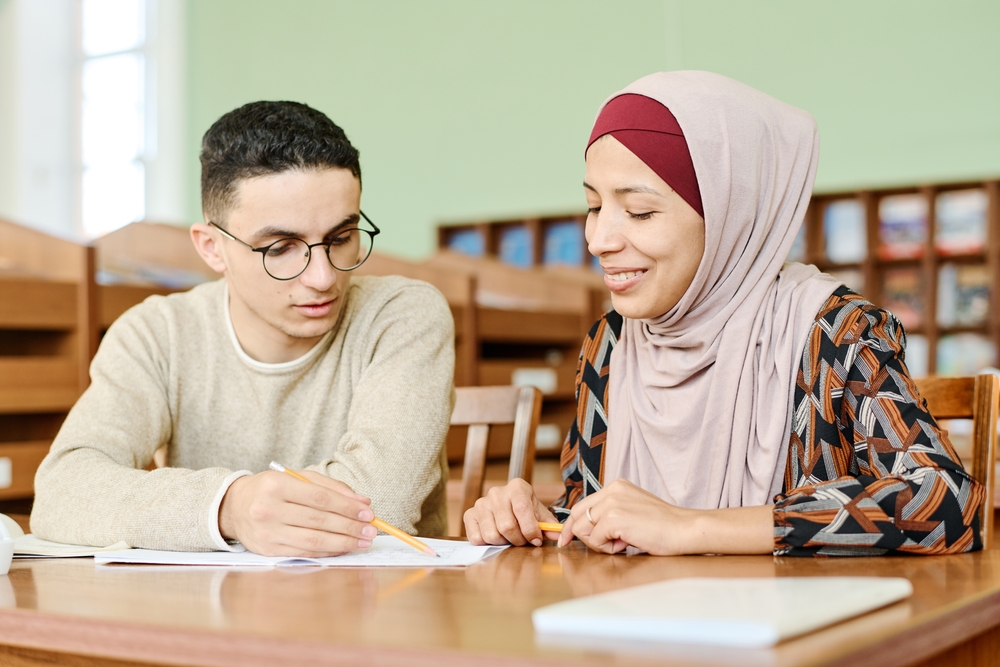By leaning on protective factors, schools can help refugee students navigate traumatic stressors and recognize their unique strengths. In this blog, we will highlight five key protective factors school settings can deploy to support refugee students’ academic achievement and well-being.
1. Supportive Connections with Adults and Peers
Positive relationships with both adults and peers are essential for the social and emotional growth of refugee students. School staff and specialists must be intentional about programs that help build strong relationships. These programs should be multi-tier—school–wide, classroom-wide, and individual. For example, schools can develop mentorship and peer-based support programs such as buddy or mentor systems, where new students are paired with more experienced students from similar cultural backgrounds. To best support refugee students, staff should regularly check in with refugee students to ensure they feel connected. School counselors, social workers, English Language Learner (ELL) teachers, and other specialists are all well positioned to build rapport with and facilitate additional connections for refugee students and their families. Strong anti-bullying initiatives and restorative justice practices can also protect refugee students, helping them build conflict resolution strategies while also cultivating empathy and understanding in other students. By fostering positive relationships with adults and peers alike, refugee students can feel valued, understood, and empowered to navigate the challenges they face.
2. Sense of Control Over One’s Life
Empowering refugee students to feel in control of their lives is essential to promoting resilience. Refugee students are likely to have faced many situations where key factors are beyond their control, very much including their family’s forcible displacement. By providing visual schedules, daily routines, and lots of repetition, schools can provide refugee students with stability and certainty, empowering them to manage the many instabilities and uncertainties that still shape their lives. Providing opportunities for leadership, decision-making, goal–setting, and active participation will also be paramount to refugee students’ personal and academic success. When refugee students first enroll in a new school, schools should welcome them with detailed orientations, explaining how the school environment is structured and what is generally expected of them while in school.
3. Sense of Belonging and Community
The feeling of belonging is fundamental to refugee students’ integration and well-being. Both in-class and after-school programs can help refugee students bond with their peers. These initiatives can also allow refugee students to give back to their community—by fostering a spirit of openness and acceptance, other students and staff discover new ideas and cultural traditions. This communal sense of belonging promotes academic engagement and emotional resilience.
4. High Self-Worth and Self-Esteem
Promoting self-worth and self-esteem is essential for the overall well-being and success of refugee students. Most refugee students experience educational disruptions due to language barriers, trauma exposure, and/or economic instability. These various stressors often take a toll on their self-esteem and can lead to behavioral challenges. Schools should implement strengths-based approaches that focus on recognizing refugee students’ unique talents, skills, and achievements. Approaching students with strategies to develop self-worth and responsibility—such as classroom jobs, student of the month awards, sharing circles, or goal–setting and reflection sessions—can help mitigate behavioral challenges. Access to counseling services, with instruction in mindfulness and coping strategies, can also equip refugee students to manage their stressors. Further opportunities to overcome academic obstacles include targeted interventions, custom goal–setting, and additional tutoring services. Because they work with refugee students individually or in small groups, ELL teachers and staff often have great perspective on how to meet these needs.
5. Family Cohesion
Most refugee students come from collective cultures, where the family unit often serves as the primary source of support and stability. Schools that recognize and honor cultural norms and values, while also providing services, resources, and interventions to address familial stressors, will bolster family bonds and increase academic achievement. Parent–teacher conferences, parenting workshops, adult English classes, community resource fairs, and other school–wide events can help integrate families into the school environment. Translating informational materials into the student’s home language, and employing interpreters and school liaisons where necessary, can help bridge communication gaps. It is also important to remember that some refugee students live in foster placements—in which case these strategies are especially crucial, since foster youth and families often require special considerations and additional community support. Many cultures do not facilitate parent participation in their children’s educations like the U.S. system does. Providing an orientation about these norms and expectations for parents and their students may be very beneficial—especially to help showcase the supports parents can receive from the school.
Conclusion
Evidence-based protective factors play a crucial role in supporting refugee students’ academic and social well-being. By prioritizing supportive connections, empowerment, belonging, self-worth, and family cohesion, schools can create nurturing environments that foster resilience, empowerment, and success. Through collaborative efforts between educators, families, and communities, we can ensure that refugee students reach their full potential.









